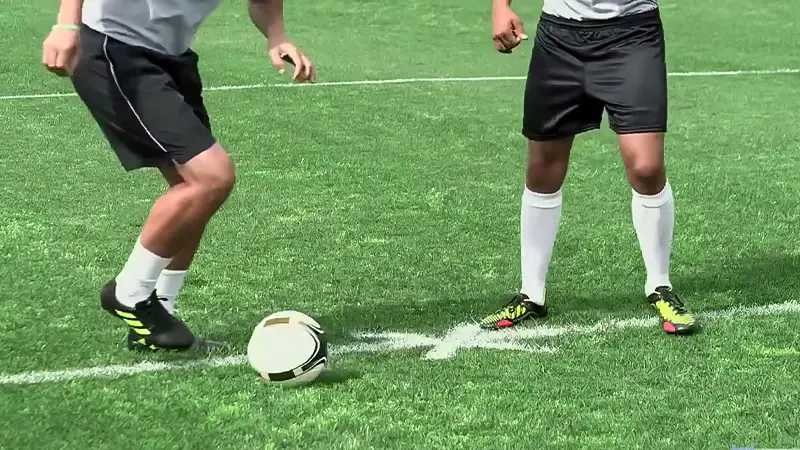The kickoff in soccer is a crucial event that initiates each half and follows a goal. It involves rules where the ball is played forward and cannot be touched again until another player interacts with it, setting the tone for fair play and strategic positioning.
Understanding and applying these rules can offer teams an advantage in shaping the game’s flow and making early plays.
Adhering to kickoff regulations allows teams to strategically control the game’s momentum from the outset, emphasizing the significance of tactical play from this starting point.
Mastering the kickoff rules in soccer is fundamental for teams aiming to gain an early advantage and dictate the game’s tempo. This pivotal event sets the stage for strategic maneuvers and player coordination, ultimately influencing the overall flow and outcome of the match.
By adhering to these regulations, teams can effectively control momentum and optimize their performance right from the start.
What is a Soccer Kickoff?
A soccer kickoff is the method to start or restart play, crucial for beginning halves, restarting after goals, and setting game tempo strategically.
Setup and Execution
During a soccer match, a kickoff is the method used to start or restart play. It is taken from the center spot by one team to begin the game, after a goal has been scored, or at the start of the second half.
The ball is initially placed in the center of the field, and the team who wins the coin toss typically chooses to take the kickoff.
Forward Movement
After the referee’s signal, the player taking the kickoff must play the ball forward. This means that the ball must move in the direction of the opponent’s half for the kickoff to be valid. It cannot be kicked backward to a teammate or in the same direction it was received from.
Restrictions on Second Touch
Once the ball is in play from the kickoff, the player who kicked it cannot touch it again until another player from either team makes contact. This rule ensures fair play and prevents a player from gaining an unfair advantage by starting the game close to the ball’s position.
Importance of Strategy
Understanding the nuances of kickoff rules is crucial for teams to strategize effectively. By positioning players strategically during a kickoff, teams can seize early opportunities, set the pace for the game, and gain a competitive edge in controlling the flow of play.
Seizing Control
A well-executed kickoff can help a team dictate the tempo of the game, maintain possession, and create scoring chances.
By adhering to the kickoff regulations and utilizing strategic positioning, teams can optimize their gameplay right from the start, giving them a better chance of success in the match.
Key Procedures for a Soccer Kickoff
Key Procedures for a Soccer Kickoff outline the essential steps and rules to effectively start or restart play, ensuring fair play and strategic advantage from the outset.
Initiating the Kickoff
When a soccer match begins, restarts after a goal, or kicks off the second half, a player from the team awarded the kickoff gets the game going.
The player taking the kickoff moves the ball forward to start play, with all opponents required to stay outside the center circle until the ball is in play. This moment marks the start of strategic positioning and setting the game’s tempo.
Player Positions During Kickoff
During a soccer kickoff, the team not taking the kickoff must be positioned outside the center circle. Moreover, the player initiating the kickoff can’t touch the ball again until another player from either team makes a legal play after the kickoff.
Understanding the proper player positions is essential to ensure compliance with the rules and maximize tactical advantages.
The Ball Placement and Movement
The ball is placed at the center spot of the field for a kickoff, signifying the beginning or resumption of play. When the referee signals, the ball is put in motion by the player taking the kickoff, who is often supported by teammates in strategic positions.
The movement of the ball from the kickoff sets the stage for dynamic play, possession retention strategies, and early opportunities to gain an edge in the match.
Essential Rules Governing Soccer Kickoffs
Soccer kickoffs are vital in starting or restarting play during a match, setting the game’s tone and offering teams a chance to gain immediate control. The procedures for kickoffs involve specific rules that players must adhere to for a fair and structured start to the game.
Scoring Directly from a Kickoff
When a player takes a kickoff at the center of the field to start a game or after a goal, scoring directly from this kick is a strategic advantage. If the ball is played into the opponent’s goal without any other player touching it, a goal is counted.
This rare feat requires precision, skill, and quick decision-making to catch the opposing team off guard.
Offside Rules in Relation to Kickoff
Offside rules apply in kickoff situations, similar to other phases of the game. When the ball is kicked during a kickoff, an attacking player cannot be in an offside position before the ball is played unless they are in their half of the field.
Understanding offside rules during kickoffs is crucial for players to strategically position themselves without committing an offside offense.
Re-kick Conditions
Certain conditions may require a re-kick during a kickoff in soccer. If the ball does not move forward or if the team taking the kickoff violates the rules by not waiting for the referee’s signal, a re-kick is awarded.
This ensures fair play and adherence to the rules to maintain the integrity of the game.
Common Violations and Penalties
Understanding the common violations and the associated penalties during a soccer kickoff is essential for maintaining fair play and ensuring that the game flows smoothly.
Here are the primary infractions and their consequences:
Infractions During Kickoff
Infractions during a soccer kickoff disrupt fair play and flow, leading to penalties. Understanding these violations helps teams maintain proper conduct and strategy.
Kicking the ball backwards
When taking a kickoff, players must kick the ball forward to start the game. Kicking the ball backward is a common violation that results in the opposition gaining possession.
Second touch
A player who takes a kickoff cannot touch the ball again until another player has touched it. If the same player touches the ball a second time before another player does, it results in a free kick for the opposing team from the spot of the infringement.
Offside position
If a player is in an offside position when receiving the kickoff pass, it constitutes a violation. Being in an offside position at the kickoff can lead to indirect free-kicks for the opponent.
Penalties for Violations
Penalties for violations during a soccer kickoff are crucial for maintaining fair play and game integrity, addressing infractions with appropriate consequences.
Indirect Free Kick
Many violations during a kickoff lead to indirect free kicks for the opposing team. This allows the opposing team to take a free kick from the spot where the violation occurred.
Rekick
In cases where there is a violation and the kickoff needs to be retaken, the team that committed the violation does not get another chance to kickoff. Instead, the opposing team gets the chance to restart the game.
Yellow Card
In situations where a violation during the kickoff is considered unsporting behavior or dissent, the offending player may receive a yellow card as a cautionary penalty.
Red Card
Severe violations during a kickoff, such as violent conduct or serious foul play, can result in the offending player receiving a red card and being sent off the field, leading to the team playing with a numerical disadvantage.
Strategic Play From Kickoff
When teams step onto the field, winning the kickoff becomes a crucial objective. Here’s why:
Advantages of Winning the Kickoff
Winning the kickoff is vital in soccer, providing teams with control, momentum, and early scoring opportunities to shape the game’s flow.
- Control Game Pace: Winning the kickoff grants a team immediate control over the ball, allowing them to dictate the pace of the game right from the start.
- Gain Initial Momentum: Securing the kickoff provides a morale boost to the team, generating early momentum and confidence to set the tone for the match.
- Create Scoring Opportunities: With possession of the ball from the kickoff, a team can swiftly transition into attacking positions, creating early scoring opportunities to put pressure on the opponents.
Strategies for Kickoff
Strategies for kickoff are essential for gaining an early advantage, allowing teams to control game pace, momentum, and scoring opportunities.
- Quick Forward Pass: A common strategy involves a quick forward pass after the kickoff to catch the opposing team off guard, aiming to exploit gaps in their defense.
- Build-up Play: Some teams opt for a slower build-up play from the kickoff, focusing on maintaining possession, circulating the ball, and gradually moving into scoring positions.
- Pressing High: Aggressive teams may choose to press high up the pitch immediately after the kickoff, aiming to win the ball back quickly and launch rapid attacks to surprise the opponents.
Recent Changes in Kickoff Rules
Recent changes in soccer kickoff rules have introduced more flexibility, allowing players to pass the ball in any direction, revolutionizing game strategies and enhancing tactical options from the start.
Modifications in the Last Five Years
- Updated FIFA regulations in recent years have brought about subtle tweaks to kickoff rules in soccer.
- One significant change includes allowing the player taking the kickoff to pass the ball to a teammate inside the center circle, altering the traditional requirement for the ball to move forward.
- These modifications have injected a new dynamic into the game, offering teams a tactical advantage right from the kickoff.
- By permitting more flexibility in the initial play, teams can now initiate intricate build-up patterns, leading to increased strategic options and creativity.
- The ability to pass the ball to a teammate from kickoff has revolutionized game flow, enabling quicker transitions and setting the tempo for the match.
Frequently Asked Questions
What are the strategic implications of soccer kickoffs?
Soccer kickoffs are crucial for controlling game pace and gaining a competitive advantage. They set the tempo for the game and offer teams strategic and creative opportunities.
Can soccer players pass the ball in any direction during a kickoff?
Yes, current rules allow players to kick off in any direction, enabling teams to implement different strategies for the game’s start.
What significant changes have occurred in soccer kickoff rules?
Recent rule changes include allowing passes from the center circle, revolutionizing game flow and creating quicker transitions for a more dynamic gameplay experience.
How do kickoff rules impact gameplay outcome?
Understanding kickoff rules helps players capitalize on scoring opportunities, maintain control, and potentially score directly from a kickoff, influencing the game’s final result.
What is the essence of kickoff rules in shaping soccer gameplay?
Kickoff rules have evolved to enhance game pace, provide teams with a competitive edge, and introduce strategic maneuvers for an exciting and intense experience for players and spectators.
Conclusion
Kickoffs in soccer play a key role in affecting the game’s tempo and offering teams a competitive advantage through strategic maneuvers, such as swift transitions and early rhythm establishment.
Adhering to kickoff rules not only ensures fair play but also creates opportunities for teams to influence the game’s outcome. Understanding the rules allows players to seize scoring chances and control the field, making scoring directly from a kickoff an exciting and unexpected element.
These rule changes have not only increased creative possibilities for teams but have also intensified gameplay, providing a more engaging experience for players and spectators alike.
Moreover, the specifics around kickoff rules underscore the importance of adherence to regulations for fair play and strategic tactics.
Players who grasp these rules gain an edge in seizing scoring chances and dictating the game’s flow for a thrilling and unpredictable match outcome.








Brice Petersen